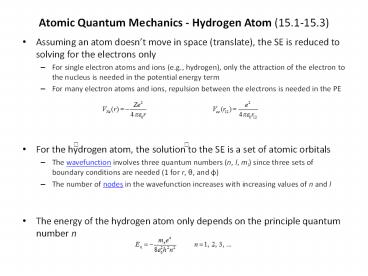Atomic Quantum Mechanics - Hydrogen Atom (15.1-15.3) - PowerPoint PPT Presentation
1 / 9
Title:
Atomic Quantum Mechanics - Hydrogen Atom (15.1-15.3)
Description:
Atomic Quantum Mechanics - Hydrogen Atom (15.1-15.3) Assuming an atom doesn t move in space (translate), the SE is reduced to solving for the electrons only – PowerPoint PPT presentation
Number of Views:48
Avg rating:3.0/5.0
Title: Atomic Quantum Mechanics - Hydrogen Atom (15.1-15.3)
1
Atomic Quantum Mechanics - Hydrogen Atom
(15.1-15.3)
- Assuming an atom doesnt move in space
(translate), the SE is reduced to solving for the
electrons only - For single electron atoms and ions (e.g.,
hydrogen), only the attraction of the electron to
the nucleus is needed in the potential energy
term - For many electron atoms and ions, repulsion
between the electrons is needed in the PE - For the hydrogen atom, the solution to the SE is
a set of atomic orbitals - The wavefunction involves three quantum numbers
(n, l, ml) since three sets of boundary
conditions are needed (1 for r, ?, and f) - The number of nodes in the wavefunction increases
with increasing values of n and l - The energy of the hydrogen atom only depends on
the principle quantum number n
2
Atomic QM Many Electron Atoms (15.6-15.7)
- When more than one electron is present, Vee must
be included in SE - Electrons are in constant motion, so potential
energy is a constantly changing variable
(electron correlation) - SE is no longer exactly solvable!
- Solutions to many electron atom SE are very
similar to hydrogen orbitals - The wavefunction for each electron is a
hydrogen-like orbital (1s, 2s, 2p, etc.) - The energy associated with each electron now
depends on n and l
(orbital filling diagram) - Two electrons can have the same principle,
angular, and magnetic quantum numbers - Electron configurations are used to show what the
atomic wavefunction looks like - Electrons posses another quantum number
associated with their spin - Electrons have another quantum number called the
spin quantum number ( 1/2) - Pauli exclusion principle states no two electrons
can have the same quantum numbers, so one
electron in an orbital must be spin-up and the
other spin-down
3
Atomic QM to Molecular QM (16.4-16.6)
- Solution of SE for molecules is more complicated
due to much larger number of electrons and
multiple nuclei - SE is still not exactly solvable since more than
one electron is involved - Atomic orbitals are not appropriate since
multiple nuclei are involved - Just as atoms combine to form molecules, atomic
orbitals (AO) should combine to form molecular
orbitals (MO) - Linear combination of atomic orbitals (LCAO) is
an approximation used to solve the molecular SE - When creating MOs from AOs, there is a one-to-one
correspondence - Atomic orbital overlap is the driving force in
whether an appropriate MO is generated (this
included orbital phases) - MOs have similar properties to AOs (and other
wavefunctions) - Two electrons can reside in each MO
- MOs are orthogonal to one another
- Energy order is related to nodal character
4
Hydrogen Wavefunctions
5
Radial Nodes in Hydrogen Orbitals
6
Angular Nodes in Hydrogen Orbitals
7
Probability Distribution Functions for Hydrogen
Orbitals
8
Orbital Filling Diagram
9
Atomic Orbital Overlap































